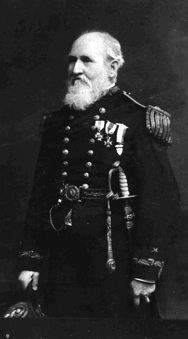Years of service 1828–1873 Rank Rear Admiral | Name Thornton Jenkins | |
 | ||
Born 11 December 1811Orange Court House, Virginia ( 1811-12-11 ) Allegiance United States United States Commands held USS ReliefUSS PrebleUSS HartfordUSS RichmondAsiatic Squadron Battles/wars Mexican–American WarAmerican Civil War Died August 9, 1893, Washington, D.C., United States Battles and wars | ||
Thornton A. Jenkins (11 December 1811 – 9 August 1893) was an officer in the United States Navy, who served during the Mexican-American War and the American Civil War. He later served as Chief of the Bureau of Navigation and as President of the United States Naval Institute. Jenkins retired as a Rear Admiral.
Contents
Early life and career
Born at Orange Court House, Virginia, Jenkins entered the Navy as a midshipman on 1 November 1828, and served first in the West Indies in an expedition against pirates and slavers. Examined for a commission as lieutenant, he placed first among 82 candidates. In 1831 Jenkins helped to suppress Nat Turner's slave rebellion.
Prior to the Mexican-American War, Jenkins served with the Coast Survey and with the Brazilian and Mediterranean Squadrons. During the war with Mexico, as executive officer of Germantown, he led landing parties from his ship at Tuxpan and Tabasco. Later, he commanded the store-ship Relief and the Supply Station at Salmedena Island. In the interval between the wars, he served in the receiving ship at Baltimore, returned to the Coast Survey, and was Secretary of the Lighthouse Board.
Civil War service
His Civil War record was distinguished. In 1861 Jenkins performed secret services for President Lincoln, until he became ill in 1861. After this, Jenkins became a captain and served primarily in the West Gulf Blockading Squadron of David Farragut, he commanded Oneida. He served as chief of staff to Farragut, and was later wounded while commanding a convoy escort group. As Senior Officer Present, in command of Richmond, he received the surrender of Port Hudson on 9 July 1863. Admiral Farragut had temporarily gone to New Orleans on business at the time. Jenkins later commanded a division of the Squadron. He was present at the Battle of Mobile Bay and heard Farragut utter the famous line "Damn the torpedoes, full speed ahead." Though, according to Thornton, what Farragut actually said was “Go ahead sir and damn the torpedoes!”
Post-war activities
Jenkins was Chief of the Bureau of Navigation, from 1865 to 1869. He became a Real Admiral in 1870 and commanded the Asiatic Squadron from 1870 until his retirement in 1873. Rear Admiral Jenkins was President of the Naval Institute from 1883 to 1885, and died on 9 August 1893. Jenkins was buried with full military honors at Arlington National Cemetery.
